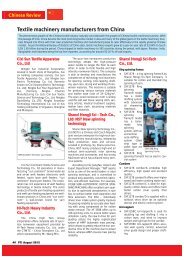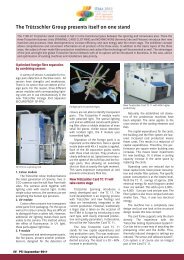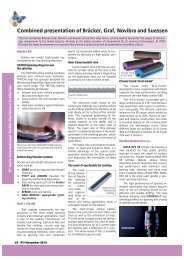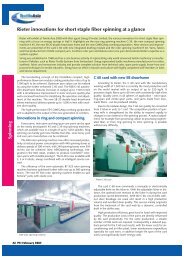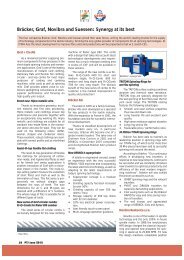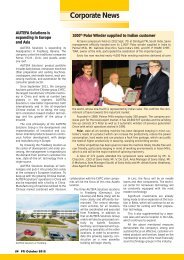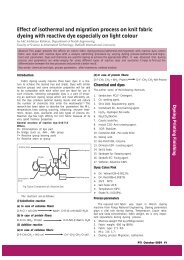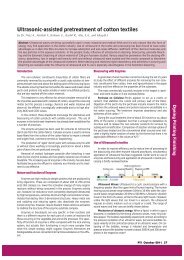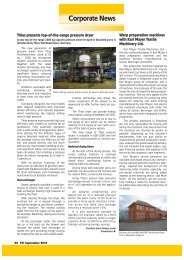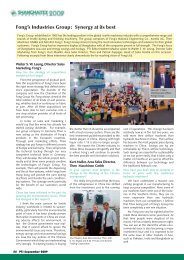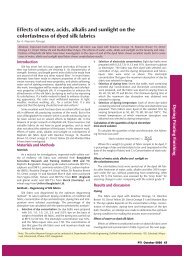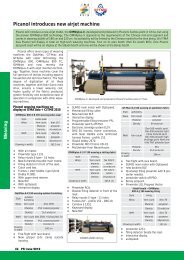Importance of fixing agent on the colour fastness of reactive dyestuff ...
Importance of fixing agent on the colour fastness of reactive dyestuff ...
Importance of fixing agent on the colour fastness of reactive dyestuff ...
You also want an ePaper? Increase the reach of your titles
YUMPU automatically turns print PDFs into web optimized ePapers that Google loves.
Dyeing Printing Finishing<br />
<str<strong>on</strong>g>Importance</str<strong>on</strong>g> <str<strong>on</strong>g>of</str<strong>on</strong>g> <str<strong>on</strong>g>fixing</str<strong>on</strong>g> <str<strong>on</strong>g>agent</str<strong>on</strong>g> <strong>on</strong> <strong>the</strong> <strong>colour</strong> <strong>fastness</strong> <str<strong>on</strong>g>of</str<strong>on</strong>g> <strong>reactive</strong><br />
<strong>dyestuff</strong> originated from various dye manufacturers<br />
Sum<strong>on</strong> Mazumder 1 and Md. Mahbubul Haque 2<br />
1 Daffodil Internati<strong>on</strong>al University, Dhaka, Bangladesh, sum<strong>on</strong>.te@daffodilvarsity.edu.bd<br />
2 Daffodil Internati<strong>on</strong>al University, Dhaka, Bangladesh, drhaque@daffodilvarsity.edu.bd<br />
Abstract: Reactive dyes are <strong>the</strong> dominant choice <str<strong>on</strong>g>of</str<strong>on</strong>g> colorants to produce <strong>colour</strong>ing effect <strong>on</strong> cott<strong>on</strong> goods for some technical advantages.<br />
Reactive dyes have a great usage due to having a wide color range and a greater color <strong>fastness</strong> rating. Most <str<strong>on</strong>g>of</str<strong>on</strong>g> <strong>the</strong> wet processing industries<br />
are using <strong>reactive</strong> dyes <strong>on</strong> textiles for colorati<strong>on</strong> purposes. Reactive dyes are <strong>the</strong> <strong>on</strong>ly class <str<strong>on</strong>g>of</str<strong>on</strong>g> dyes which make co-valent b<strong>on</strong>d with<br />
<strong>the</strong> fibre molecules, so <strong>the</strong> <strong>colour</strong> <strong>fastness</strong> characteristics become greater. After treatment is carried out in <strong>reactive</strong> dyeing to remove <strong>the</strong><br />
weakly b<strong>on</strong>ded unfix dyes from <strong>the</strong> fibre substrate. However, <str<strong>on</strong>g>fixing</str<strong>on</strong>g> <str<strong>on</strong>g>agent</str<strong>on</strong>g> may be induced after <strong>reactive</strong> dyeing to improve <strong>the</strong> stability<br />
<str<strong>on</strong>g>of</str<strong>on</strong>g> previously formed co-valent b<strong>on</strong>d between dye and fibre molecules. The aim <str<strong>on</strong>g>of</str<strong>on</strong>g> this paper is to study <strong>the</strong> effects <str<strong>on</strong>g>of</str<strong>on</strong>g> <str<strong>on</strong>g>fixing</str<strong>on</strong>g> <str<strong>on</strong>g>agent</str<strong>on</strong>g> <strong>on</strong><br />
cott<strong>on</strong> fabric dyed with <strong>reactive</strong> dye. For <strong>the</strong> determinati<strong>on</strong> <str<strong>on</strong>g>of</str<strong>on</strong>g> <strong>the</strong>se effects, Colour <strong>fastness</strong> properties and <strong>colour</strong> difference values have<br />
been measured in case <str<strong>on</strong>g>of</str<strong>on</strong>g> dyed cott<strong>on</strong> material before and after using <str<strong>on</strong>g>fixing</str<strong>on</strong>g> <str<strong>on</strong>g>agent</str<strong>on</strong>g>.<br />
Key words: co-valent b<strong>on</strong>d, cross-linking <str<strong>on</strong>g>agent</str<strong>on</strong>g>, gossypium, beta-glucose, <strong>colour</strong> <strong>fastness</strong>.<br />
1. Introducti<strong>on</strong><br />
Cott<strong>on</strong> is <strong>the</strong> purest form <str<strong>on</strong>g>of</str<strong>on</strong>g> cellulose found in nature, is <strong>the</strong><br />
seed hair <str<strong>on</strong>g>of</str<strong>on</strong>g> plants <str<strong>on</strong>g>of</str<strong>on</strong>g> <strong>the</strong> genus gossypium. [1] Cellulose is <strong>the</strong><br />
most comm<strong>on</strong> organic compound <strong>on</strong> Earth. About 33 percent <str<strong>on</strong>g>of</str<strong>on</strong>g><br />
all plant matter is cellulose (<strong>the</strong> cellulose c<strong>on</strong>tent <str<strong>on</strong>g>of</str<strong>on</strong>g> cott<strong>on</strong> is 90<br />
percent and that <str<strong>on</strong>g>of</str<strong>on</strong>g> wood is 50 percent). [2] Cellulose is an organic<br />
compound with <strong>the</strong> formula (C 6 H 10 O 5 )n, a polysaccharide c<strong>on</strong>sisting<br />
<str<strong>on</strong>g>of</str<strong>on</strong>g> a linear chain <str<strong>on</strong>g>of</str<strong>on</strong>g> several hundred to over ten thousand<br />
β(1→4) linked D-glucose units. [3]<br />
Figure 1: Polysaccharide c<strong>on</strong>sisting <str<strong>on</strong>g>of</str<strong>on</strong>g> β (1 4) linked D-glucose units.<br />
Cellulose m<strong>on</strong>omers (beta-glucose) are linked toge<strong>the</strong>r<br />
through 1, 4 glycosidic b<strong>on</strong>ds. Cellulose is a straight chain and no<br />
coiling occurs. Of <strong>the</strong> three hydroxyl groups <strong>on</strong> <strong>the</strong> cellulose<br />
rings, two are sec<strong>on</strong>dary, and <strong>on</strong>e is a primary. Most reacti<strong>on</strong>s<br />
with cellulose occur at <strong>the</strong> primary hydroxyl group. Cott<strong>on</strong> naturally<br />
c<strong>on</strong>tains oils, fats, waxes, minerals, leafy matters, motes etc<br />
as impurities that interfere in dyeing and finishing.<br />
The process <str<strong>on</strong>g>of</str<strong>on</strong>g> removing <strong>the</strong>se impurities from cott<strong>on</strong> is called<br />
as scouring. [4] Usually cott<strong>on</strong> fibres are <str<strong>on</strong>g>of</str<strong>on</strong>g>f-white in <strong>colour</strong> due<br />
to having <strong>colour</strong> bodies with it and <strong>the</strong> process <str<strong>on</strong>g>of</str<strong>on</strong>g> destructi<strong>on</strong><br />
<strong>the</strong>se <strong>colour</strong> bodies from fibres is known as bleaching. [5] Before<br />
cott<strong>on</strong> fibre colorati<strong>on</strong> with <strong>reactive</strong> dyes, scouring and bleaching<br />
process is essential to perform for producing even <strong>colour</strong> <strong>on</strong> fibre<br />
substrate.<br />
Reactive dyes have water solubility and can posses various<br />
<strong>reactive</strong> groups which during <strong>the</strong> process <str<strong>on</strong>g>of</str<strong>on</strong>g> dyeing (during<br />
dyeing <str<strong>on</strong>g>of</str<strong>on</strong>g> cellulosic material with fibre-<strong>reactive</strong> dyes) react chemically<br />
with <strong>the</strong> fibre substrate to form a co-valent b<strong>on</strong>d in presence<br />
<str<strong>on</strong>g>of</str<strong>on</strong>g> alkali so that it becomes a part <str<strong>on</strong>g>of</str<strong>on</strong>g> <strong>the</strong> fibre itself. [6]<br />
Dye-X + OH-Cell Dye-O-Cell<br />
Reactive dye (Permanently fixed dyes)<br />
(X is <strong>the</strong> <strong>reactive</strong> comp<strong>on</strong>ent)<br />
44 PTJ April 2011<br />
The two most comm<strong>on</strong>ly encountered <strong>reactive</strong> dyes have<br />
chlorotriazine (CT), vinyl sulf<strong>on</strong>e (VS), or CT-VS heterobifuncti<strong>on</strong>al<br />
functi<strong>on</strong>ality. Reactive dyes form covalent e<strong>the</strong>r b<strong>on</strong>ds like<br />
above with cellulose. With <strong>the</strong> chlorotriazine <strong>reactive</strong> group, <strong>the</strong><br />
Cl group is replaced by <strong>the</strong> Cell-O- group through a nucleophilic<br />
substituti<strong>on</strong> reacti<strong>on</strong>. Both types <str<strong>on</strong>g>of</str<strong>on</strong>g> <strong>reactive</strong> groups can be used in<br />
<strong>the</strong> same dye structure to increase fixati<strong>on</strong>. Reactive dye classes<br />
include trichloropyrimidine, m<strong>on</strong>o-chlorotriazine (MCT), carboxypyridino<br />
triazine, dichloroquinoxaline, m<strong>on</strong><str<strong>on</strong>g>of</str<strong>on</strong>g>luoro- triazine,<br />
difluoropyrimidine, difluorochloro- pyrimidine, and phosph<strong>on</strong>ic<br />
acid dyes. Reacti<strong>on</strong> between <strong>the</strong> dye and cellulose can occur<br />
when <strong>the</strong> dye has been absorbed into <strong>the</strong> cellulose phase. Thus<br />
<strong>the</strong> kinetic <str<strong>on</strong>g>of</str<strong>on</strong>g> <strong>the</strong> dye cellulose reacti<strong>on</strong> are str<strong>on</strong>gly influenced by<br />
<strong>the</strong> rate <str<strong>on</strong>g>of</str<strong>on</strong>g> absorpti<strong>on</strong> <str<strong>on</strong>g>of</str<strong>on</strong>g> dye.<br />
The ratio <str<strong>on</strong>g>of</str<strong>on</strong>g> <strong>the</strong> rate c<strong>on</strong>stant for reacti<strong>on</strong> <str<strong>on</strong>g>of</str<strong>on</strong>g> <strong>the</strong> dye with <strong>the</strong><br />
fibre and with water is a c<strong>on</strong>stant for a given dye over a wide<br />
range <str<strong>on</strong>g>of</str<strong>on</strong>g> alkaline pH values. [7] The processing <str<strong>on</strong>g>of</str<strong>on</strong>g> cott<strong>on</strong> with fibre<br />
<strong>reactive</strong> dyes requires <strong>the</strong> following aspects to be c<strong>on</strong>sidered:<br />
electrolyte, bath ratio, alkali (pH) and temperature. Most (98%)<br />
commercial <strong>reactive</strong> dyes are fixed under alkaline c<strong>on</strong>diti<strong>on</strong>s.In<br />
order to achive maximum wash <strong>fastness</strong> <str<strong>on</strong>g>of</str<strong>on</strong>g> a <strong>reactive</strong> dyeing, <strong>the</strong><br />
hydrolysed dye which is present in <strong>the</strong> fibre and held by weaker<br />
affinity forces, than covalency, should be completely removed, as<br />
o<strong>the</strong>rwise it would lower <strong>the</strong> wash <strong>fastness</strong> <str<strong>on</strong>g>of</str<strong>on</strong>g> <strong>the</strong> dyeing because<br />
<str<strong>on</strong>g>of</str<strong>on</strong>g> its lower substantivity to cellulose. That is usually removed by<br />
soaping treatment at <strong>the</strong> boil. [8]<br />
After soaping, <str<strong>on</strong>g>fixing</str<strong>on</strong>g> process is carried out <strong>on</strong> dyed material<br />
with <str<strong>on</strong>g>fixing</str<strong>on</strong>g> <str<strong>on</strong>g>agent</str<strong>on</strong>g> to prevent color bleeding during subsequent<br />
washing and improve different color <strong>fastness</strong> properties. Fixing<br />
<str<strong>on</strong>g>agent</str<strong>on</strong>g> is a cross-linking <str<strong>on</strong>g>agent</str<strong>on</strong>g> which would form a str<strong>on</strong>g bridge<br />
between <strong>the</strong> cellulose and <strong>the</strong> dye, <strong>the</strong>reby anchoring <strong>the</strong> latter<br />
to <strong>the</strong> fibre. [9]<br />
2. Materials & methods<br />
2.1. Materials selecti<strong>on</strong>:<br />
The investigati<strong>on</strong> has been carried out with currently popular<br />
Single jersey knitted fabric. Basic characteristics <str<strong>on</strong>g>of</str<strong>on</strong>g> single jersey<br />
fabric are menti<strong>on</strong>ed below:<br />
Fabric compositi<strong>on</strong> – 100% cott<strong>on</strong><br />
Fabric type – Single jersey weft knitted fabric.<br />
Yarn count – 30/s<br />
Fabric G.S.M –158<br />
Fabric wt – 10 gm
2.2 Method <str<strong>on</strong>g>of</str<strong>on</strong>g> Scouring and Bleaching:<br />
The process by which natural <strong>colour</strong> bodies are completely<br />
removed and permanent whiteness effects are produced <strong>on</strong> fabric<br />
is called bleaching. Scouring was d<strong>on</strong>e in combine with bleaching<br />
process to remove impurities from cott<strong>on</strong> fabric. Following recipe<br />
has been introduced for those purposes-<br />
Detergent (Sandoclean PCLF) -1 g/l<br />
Peroxide Stabilizer -0.75 g/l<br />
Bleaching Agent (H2O2 ) -4 g/l<br />
Alkali (NaOH) -3g/l<br />
Sequestering Agent (UDX) -0.5 g/l<br />
Temperature - 95˚C<br />
Time – 1hour<br />
Material: Liquor – 1:10<br />
Figure 2: Scouring and bleaching curve.<br />
2.3 Method <str<strong>on</strong>g>of</str<strong>on</strong>g> dyeing:<br />
In this investigati<strong>on</strong> <strong>reactive</strong> dyes <str<strong>on</strong>g>of</str<strong>on</strong>g> red hue have been taken<br />
for dyeing <strong>the</strong> bleached fabric with shade 0.5% and 1.5%. Dye-<br />
A, Dye-B and Dye-C have been collected from three <strong>reactive</strong><br />
<strong>dyestuff</strong> manufacturers.<br />
Table 1: Dyeing recipe with Dye-A, Dye-B and Dye-C<br />
Dyeing Parameters 0.5% shade 1.5% shade<br />
Reactive dyes (Dye-A,<br />
Dye-B, Dye-C)<br />
0.5% 1.5%<br />
Comm<strong>on</strong> salt (g/l) 20 45<br />
Soda ash (g/l) 5 12<br />
Levelling <str<strong>on</strong>g>agent</str<strong>on</strong>g> (g/l) 0.5 0.5<br />
Temperature (˚C) 60 60<br />
Run time (minutes) 60 60<br />
Material: liquor 1:10 1:10<br />
Figure 3: Dyeing curve.<br />
2.4 Method <str<strong>on</strong>g>of</str<strong>on</strong>g> soaping<br />
After dyeing soaping treatment was carried out <strong>on</strong> dyed samples<br />
with recipe menti<strong>on</strong>ed below:<br />
Soaping <str<strong>on</strong>g>agent</str<strong>on</strong>g> – 1 g/l<br />
Temperature - 60˚C<br />
Time – 5 minutes<br />
Material: Liquor – 1:10<br />
Figure 4: Soaping curve.<br />
2.5 Method <str<strong>on</strong>g>of</str<strong>on</strong>g> neutralizati<strong>on</strong><br />
After <strong>the</strong> soaping treatment, neutralizati<strong>on</strong> has been performed<br />
<strong>on</strong> dyed fabric at normal temperature with 0.5 g/l acetic<br />
acid to remove <strong>the</strong> residual alkalinity if present in fabric.<br />
2.6 Method <str<strong>on</strong>g>of</str<strong>on</strong>g> <str<strong>on</strong>g>fixing</str<strong>on</strong>g>:<br />
Fixing is d<strong>on</strong>e by using <str<strong>on</strong>g>fixing</str<strong>on</strong>g> <str<strong>on</strong>g>agent</str<strong>on</strong>g> after soaping process.<br />
Following recipe & procedure was used for <strong>the</strong> fixati<strong>on</strong> <str<strong>on</strong>g>of</str<strong>on</strong>g> <strong>reactive</strong><br />
dyes with fibre.<br />
Fixing <str<strong>on</strong>g>agent</str<strong>on</strong>g> – 1 g/l<br />
Temperature - 45˚C<br />
Time – 10 minute<br />
Material: Liquor – 1:10<br />
Figure 5: Fixing curve.<br />
2.7 Method <str<strong>on</strong>g>of</str<strong>on</strong>g> Testing:<br />
Different testing standard procedures have been followed for<br />
<strong>the</strong> assessment <str<strong>on</strong>g>of</str<strong>on</strong>g> <strong>colour</strong> <strong>fastness</strong> properties and <strong>colour</strong> difference<br />
values am<strong>on</strong>g <strong>the</strong> dyed samples before and after <str<strong>on</strong>g>fixing</str<strong>on</strong>g> treatment.<br />
2.7.1Color <strong>fastness</strong> to rubbing (wet & dry):<br />
Colour<strong>fastness</strong> to both dry and wet rubbing <str<strong>on</strong>g>of</str<strong>on</strong>g> dyed cott<strong>on</strong><br />
single jersey fabric was assessed by following standard method<br />
ISO 105 X12.<br />
2.7.2 Colour <strong>fastness</strong> to washing:<br />
Colour<strong>fastness</strong> to wash <str<strong>on</strong>g>of</str<strong>on</strong>g> dyed cott<strong>on</strong> single jersey fabric was<br />
assessed by following standard method ISO105-C2S.<br />
2.7.3 Colour difference (∆E) measurement:<br />
By using <strong>the</strong> Spectrophotometer, firstly dyed sample without<br />
<str<strong>on</strong>g>fixing</str<strong>on</strong>g> is taken as standard. Then <strong>the</strong> <strong>colour</strong> difference (∆E) am<strong>on</strong>g<br />
<strong>the</strong> samples before and after <str<strong>on</strong>g>fixing</str<strong>on</strong>g> was measured. SF-600 model<br />
<str<strong>on</strong>g>of</str<strong>on</strong>g> DATA COLOR (USA) was used for <strong>the</strong> measurement <str<strong>on</strong>g>of</str<strong>on</strong>g> Colour<br />
difference (∆E) value.<br />
3.0 Results & discussi<strong>on</strong>s<br />
3.1 Effects <str<strong>on</strong>g>of</str<strong>on</strong>g> <str<strong>on</strong>g>fixing</str<strong>on</strong>g> <str<strong>on</strong>g>agent</str<strong>on</strong>g> <strong>on</strong> <strong>colour</strong> <strong>fastness</strong> to rubbing <str<strong>on</strong>g>of</str<strong>on</strong>g> different<br />
shades:<br />
Table 2: Effects <str<strong>on</strong>g>of</str<strong>on</strong>g> <str<strong>on</strong>g>fixing</str<strong>on</strong>g> <str<strong>on</strong>g>agent</str<strong>on</strong>g> <strong>on</strong> <strong>colour</strong><strong>fastness</strong> to<br />
dry rubbing <str<strong>on</strong>g>of</str<strong>on</strong>g> 0.5% shade<br />
(Grey scale rating for <strong>colour</strong> change)<br />
Sample (After different Process) Dye A Dye B Dye C<br />
Dyed Sample 4-5 4 4-5<br />
After Soaping 4-5 4-5 5<br />
After Soaping and Fixing 5 4-5 5<br />
PTJ April 2011 45<br />
Dyeing Printing Finishing
Dyeing Printing Finishing<br />
Figure 6: Colour<strong>fastness</strong> to dry rubbing <str<strong>on</strong>g>of</str<strong>on</strong>g> various dyes for 0.5 % shade.<br />
The figure is showing that after using <str<strong>on</strong>g>fixing</str<strong>on</strong>g> <str<strong>on</strong>g>agent</str<strong>on</strong>g> <strong>the</strong> <strong>colour</strong><br />
<strong>fastness</strong> to dry rubbing is increased for all dyes, where excepti<strong>on</strong><br />
has been found if <str<strong>on</strong>g>fixing</str<strong>on</strong>g> is not d<strong>on</strong>e after dyeing process. So, from<br />
<strong>the</strong> above figure it can be said that <strong>the</strong> <strong>colour</strong><strong>fastness</strong> to dry rubbing<br />
<str<strong>on</strong>g>of</str<strong>on</strong>g> dye (A) and (C) is superior to dye (B) though same <str<strong>on</strong>g>fixing</str<strong>on</strong>g><br />
<str<strong>on</strong>g>agent</str<strong>on</strong>g> was used during <str<strong>on</strong>g>fixing</str<strong>on</strong>g> process.<br />
Table 3: Effect <str<strong>on</strong>g>of</str<strong>on</strong>g> <str<strong>on</strong>g>fixing</str<strong>on</strong>g> <str<strong>on</strong>g>agent</str<strong>on</strong>g> <strong>on</strong> <strong>colour</strong><strong>fastness</strong><br />
to wet rubbing <str<strong>on</strong>g>of</str<strong>on</strong>g> 0.5% shade<br />
(Grey scale rating for <strong>colour</strong> change)<br />
Sample (After different Process) Dye A Dye B Dye C<br />
Dyed Sample 3-4 3-4 4<br />
After Soaping 4 4 4-5<br />
After Soaping and Fixing 5 4-5 5<br />
Figure 7: Colour<strong>fastness</strong> to wet rubbing <str<strong>on</strong>g>of</str<strong>on</strong>g> various dyes for 0.5 % shade.<br />
The figure is showing that after using <str<strong>on</strong>g>fixing</str<strong>on</strong>g> <str<strong>on</strong>g>agent</str<strong>on</strong>g> <strong>the</strong> <strong>colour</strong><br />
<strong>fastness</strong> to wet rubbing is increased for all dyes, where excepti<strong>on</strong><br />
has been found if <str<strong>on</strong>g>fixing</str<strong>on</strong>g> is not d<strong>on</strong>e after dyeing process. So, from<br />
<strong>the</strong> above figure it can also be said that <strong>the</strong> <strong>colour</strong><strong>fastness</strong> to wet<br />
rubbing <str<strong>on</strong>g>of</str<strong>on</strong>g> dye (A) and (C) is superior to dye (B) though same<br />
<str<strong>on</strong>g>fixing</str<strong>on</strong>g> <str<strong>on</strong>g>agent</str<strong>on</strong>g> was used during <str<strong>on</strong>g>fixing</str<strong>on</strong>g> process.<br />
Table 4: Effects <str<strong>on</strong>g>of</str<strong>on</strong>g> <str<strong>on</strong>g>fixing</str<strong>on</strong>g> <str<strong>on</strong>g>agent</str<strong>on</strong>g> <strong>on</strong> <strong>colour</strong> <strong>fastness</strong> to<br />
dry rubbing <str<strong>on</strong>g>of</str<strong>on</strong>g> 1.5% shade<br />
(Grey scale rating for <strong>colour</strong> change)<br />
Sample (After different Process) Dye A Dye B Dye C<br />
46 PTJ April 2011<br />
Dyed Sample 3-4 4 4<br />
After Soaping 4 4 4-5<br />
After Soaping and Fixing 4-5 5 5<br />
Figure 8: Colour<strong>fastness</strong> to dry rubbing <str<strong>on</strong>g>of</str<strong>on</strong>g> various dyes for 1.5 % shade.<br />
The figure is showing that after using <str<strong>on</strong>g>fixing</str<strong>on</strong>g> <str<strong>on</strong>g>agent</str<strong>on</strong>g> <strong>the</strong> <strong>colour</strong><br />
<strong>fastness</strong> to dry rubbing is increased for all dyes, where excepti<strong>on</strong><br />
has been found if <str<strong>on</strong>g>fixing</str<strong>on</strong>g> is not d<strong>on</strong>e after dyeing process. So, from<br />
<strong>the</strong> above figure it can also be said that <strong>the</strong> <strong>colour</strong><strong>fastness</strong> to dry<br />
rubbing <str<strong>on</strong>g>of</str<strong>on</strong>g> dye (B) and (C) is superior to dye (A) though same<br />
<str<strong>on</strong>g>fixing</str<strong>on</strong>g> <str<strong>on</strong>g>agent</str<strong>on</strong>g> was used during <str<strong>on</strong>g>fixing</str<strong>on</strong>g> process.<br />
Table 5: Effects <str<strong>on</strong>g>of</str<strong>on</strong>g> <str<strong>on</strong>g>fixing</str<strong>on</strong>g> <str<strong>on</strong>g>agent</str<strong>on</strong>g> <strong>on</strong> <strong>colour</strong><strong>fastness</strong> to<br />
wet rubbing <str<strong>on</strong>g>of</str<strong>on</strong>g> 1.5% shade<br />
(Grey scale rating for <strong>colour</strong> change)<br />
Sample (After different processes) Dye A Dye B Dye C<br />
Dyed Sample 3-4 3-4 4<br />
After Soaping 4 4 4<br />
After Soaping and Fixing 4 4-5 4-5<br />
Figure 9: Colour<strong>fastness</strong> to wet rubbing <str<strong>on</strong>g>of</str<strong>on</strong>g> various dyes for 1.5 % shade.<br />
The figure is showing that after using <str<strong>on</strong>g>fixing</str<strong>on</strong>g> <str<strong>on</strong>g>agent</str<strong>on</strong>g> <strong>the</strong> <strong>colour</strong><br />
<strong>fastness</strong> to wet rubbing is increased for all dyes, where excepti<strong>on</strong><br />
has been found if <str<strong>on</strong>g>fixing</str<strong>on</strong>g> is not d<strong>on</strong>e after dyeing process. So, from<br />
<strong>the</strong> above figure it can also be said that <strong>the</strong> <strong>colour</strong><strong>fastness</strong> to wet<br />
rubbing <str<strong>on</strong>g>of</str<strong>on</strong>g> dye (B) and (C) is superior to dye (A) though same<br />
<str<strong>on</strong>g>fixing</str<strong>on</strong>g> <str<strong>on</strong>g>agent</str<strong>on</strong>g> was used during <str<strong>on</strong>g>fixing</str<strong>on</strong>g> process.<br />
3.2 Effects <str<strong>on</strong>g>of</str<strong>on</strong>g> <str<strong>on</strong>g>fixing</str<strong>on</strong>g> <str<strong>on</strong>g>agent</str<strong>on</strong>g> <strong>on</strong> <strong>colour</strong> <strong>fastness</strong> to washing <str<strong>on</strong>g>of</str<strong>on</strong>g><br />
different shades:<br />
Table 6: Effect <str<strong>on</strong>g>of</str<strong>on</strong>g> <str<strong>on</strong>g>fixing</str<strong>on</strong>g> <str<strong>on</strong>g>agent</str<strong>on</strong>g> <strong>on</strong> <strong>colour</strong><strong>fastness</strong> to<br />
wash <str<strong>on</strong>g>of</str<strong>on</strong>g> 0.5% shade (Grey scale rating)<br />
Sample (After different Process) Dye A Dye B Dye C<br />
Dyed Sample 3 4 3-4<br />
After Soaping 3-4 3-4 4<br />
After Soaping and Fixing 4-5 4 4-5
Figure 10: Colour<strong>fastness</strong> to wash <str<strong>on</strong>g>of</str<strong>on</strong>g> various dyes for 0.5 % shade.<br />
The figure is showing that after using <str<strong>on</strong>g>fixing</str<strong>on</strong>g> <str<strong>on</strong>g>agent</str<strong>on</strong>g> <strong>the</strong> <strong>colour</strong><br />
<strong>fastness</strong> to wash is increased for all dyes, where excepti<strong>on</strong> has<br />
been found if <str<strong>on</strong>g>fixing</str<strong>on</strong>g> is not d<strong>on</strong>e after dyeing process. So, from <strong>the</strong><br />
above figure it can also be said that <strong>the</strong> <strong>colour</strong><strong>fastness</strong> to wash <str<strong>on</strong>g>of</str<strong>on</strong>g><br />
dye (A) and (C) is superior to dye (B) though same <str<strong>on</strong>g>fixing</str<strong>on</strong>g> <str<strong>on</strong>g>agent</str<strong>on</strong>g><br />
was used during <str<strong>on</strong>g>fixing</str<strong>on</strong>g> process.<br />
Table 7: Effect <str<strong>on</strong>g>of</str<strong>on</strong>g> <str<strong>on</strong>g>fixing</str<strong>on</strong>g> <str<strong>on</strong>g>agent</str<strong>on</strong>g> <strong>on</strong> <strong>colour</strong><strong>fastness</strong> to<br />
wash <str<strong>on</strong>g>of</str<strong>on</strong>g> 1.5% shade<br />
(Grey scale rating for <strong>colour</strong> change)<br />
Sample (After different Process) Dye A Dye B Dye C<br />
Dyed Sample 3-4 4 4<br />
After Soaping 4 4 4<br />
After Soaping and Fixing 4-5 4-5 4-5<br />
Figure 11: Colour<strong>fastness</strong> to wash <str<strong>on</strong>g>of</str<strong>on</strong>g> various dyes for 1.5 % shade.<br />
The figure is showing that after using <str<strong>on</strong>g>fixing</str<strong>on</strong>g> <str<strong>on</strong>g>agent</str<strong>on</strong>g> <strong>the</strong> <strong>colour</strong><br />
<strong>fastness</strong> to wash is increased for all dyes, where excepti<strong>on</strong> has<br />
been found if <str<strong>on</strong>g>fixing</str<strong>on</strong>g> is not d<strong>on</strong>e after dyeing process. So, from <strong>the</strong><br />
above figure it can also be said that <strong>the</strong> <strong>colour</strong><strong>fastness</strong> to wash <str<strong>on</strong>g>of</str<strong>on</strong>g>f<br />
dye (A), dye (B) and dye (C) is good.<br />
3.3 Effects <str<strong>on</strong>g>of</str<strong>on</strong>g> <str<strong>on</strong>g>fixing</str<strong>on</strong>g> <str<strong>on</strong>g>agent</str<strong>on</strong>g> <strong>on</strong> Colour difference (∆E) am<strong>on</strong>g<br />
different shades:<br />
Table 8: Effect <str<strong>on</strong>g>of</str<strong>on</strong>g> <str<strong>on</strong>g>fixing</str<strong>on</strong>g> <str<strong>on</strong>g>agent</str<strong>on</strong>g> <strong>on</strong> Colour<br />
difference <str<strong>on</strong>g>of</str<strong>on</strong>g> 0.5% shade<br />
(Spectrophotometer readings)<br />
Colour difference (∆E) between dyed<br />
sample and sample without Fixing<br />
Colour difference (∆E) between dyed<br />
sample and sample with Fixing<br />
Figure 12: Colour difference (∆E) value <str<strong>on</strong>g>of</str<strong>on</strong>g> various samples.<br />
Dye A Dye B Dye C<br />
4.9 4.2 2.64<br />
2.18 3.15 0.64<br />
The figure is showing that after using <str<strong>on</strong>g>fixing</str<strong>on</strong>g> <str<strong>on</strong>g>agent</str<strong>on</strong>g> <strong>the</strong> <strong>colour</strong> difference<br />
(∆E) am<strong>on</strong>g various samples is decreased significantly for all dyes,<br />
where excepti<strong>on</strong> has been found if <str<strong>on</strong>g>fixing</str<strong>on</strong>g> is not d<strong>on</strong>e after dyeing<br />
process. So, from <strong>the</strong> above figure it can be said that <strong>the</strong> <strong>colour</strong> difference<br />
is decreased in greater amount after <str<strong>on</strong>g>fixing</str<strong>on</strong>g> in case <str<strong>on</strong>g>of</str<strong>on</strong>g> dye (A) as<br />
compare to dye (B) and dye (C). Again <strong>colour</strong> difference was minimum<br />
for samples dyed with dye (C) before and after <str<strong>on</strong>g>fixing</str<strong>on</strong>g>.<br />
Table 9: Effect <str<strong>on</strong>g>of</str<strong>on</strong>g> <str<strong>on</strong>g>fixing</str<strong>on</strong>g> <str<strong>on</strong>g>agent</str<strong>on</strong>g> <strong>on</strong> Colour difference<br />
<str<strong>on</strong>g>of</str<strong>on</strong>g> 1.5% shade (Spectrophotometer readings)<br />
Colour difference (∆E) between dyed<br />
sample and sample without Fixing<br />
Colour difference (∆E) between dyed<br />
sample and sample with Fixing<br />
Figure 13: Colour difference ( E) value <str<strong>on</strong>g>of</str<strong>on</strong>g> various samples.<br />
The figure is showing that after using <str<strong>on</strong>g>fixing</str<strong>on</strong>g> <str<strong>on</strong>g>agent</str<strong>on</strong>g> <strong>the</strong> <strong>colour</strong> difference<br />
(∆E) am<strong>on</strong>g various samples is decreased significantly for all dyes,<br />
where excepti<strong>on</strong> has been found if <str<strong>on</strong>g>fixing</str<strong>on</strong>g> is not d<strong>on</strong>e after dyeing<br />
process. So, from <strong>the</strong> above figure it can be said that <strong>the</strong> <strong>colour</strong> difference<br />
is minimum for samples dyed with dye (C) before and after <str<strong>on</strong>g>fixing</str<strong>on</strong>g>.<br />
4.0 C<strong>on</strong>clusi<strong>on</strong><br />
After <strong>the</strong> completi<strong>on</strong> <str<strong>on</strong>g>of</str<strong>on</strong>g> this investigati<strong>on</strong> it has been observed<br />
that after using <str<strong>on</strong>g>fixing</str<strong>on</strong>g> <str<strong>on</strong>g>agent</str<strong>on</strong>g>, <strong>the</strong> <strong>colour</strong> <strong>fastness</strong> <str<strong>on</strong>g>of</str<strong>on</strong>g> <strong>reactive</strong> dyed<br />
cott<strong>on</strong> fabric is increased significantly in case <str<strong>on</strong>g>of</str<strong>on</strong>g> dye (C) as compared<br />
to dye (A) and dye (B). Again, <strong>colour</strong> difference (∆E)<br />
am<strong>on</strong>g <strong>the</strong> various samples at different stages for dye (C) has<br />
been reduced after using <str<strong>on</strong>g>fixing</str<strong>on</strong>g> <str<strong>on</strong>g>agent</str<strong>on</strong>g>. So, <str<strong>on</strong>g>fixing</str<strong>on</strong>g> <str<strong>on</strong>g>agent</str<strong>on</strong>g> showed<br />
greater effects in case <str<strong>on</strong>g>of</str<strong>on</strong>g> <strong>reactive</strong> dye (C) and thus its effects<br />
depend <strong>on</strong> different types <str<strong>on</strong>g>of</str<strong>on</strong>g> manufactured <strong>reactive</strong> dyes.<br />
Colour<strong>fastness</strong> tests are very much important in case <str<strong>on</strong>g>of</str<strong>on</strong>g> textile<br />
processing for <strong>the</strong> selecti<strong>on</strong> <str<strong>on</strong>g>of</str<strong>on</strong>g> suitable dyes.<br />
By <strong>the</strong>se tests it was possible to know and asses how l<strong>on</strong>g <strong>the</strong><br />
<strong>colour</strong> would be retained in textiles material, its l<strong>on</strong>gevity, substantivity,<br />
resistance etc. All <strong>the</strong> tests were executed according to world<br />
recognized ISO standards. Colour <strong>fastness</strong> to washing, rubbing is<br />
very much important criteri<strong>on</strong> to buy a dyed cloth. So, it is necessary<br />
to study <strong>the</strong> importance <str<strong>on</strong>g>of</str<strong>on</strong>g> <str<strong>on</strong>g>fixing</str<strong>on</strong>g> <str<strong>on</strong>g>agent</str<strong>on</strong>g> <strong>on</strong> cott<strong>on</strong> fabric dyed with<br />
<strong>reactive</strong> dyes supplied from various dye manufacturers.<br />
References<br />
Dye A Dye B Dye C<br />
1.9 1.7 1.35<br />
1.1 0.9 0.75<br />
[1] John Shore: Cellulosics dyeing, 1995: pp. 01<br />
[2] Encyclopedia Britannica Online, Retrieved January 11, 2008.<br />
[3] http://en.wikipedia.org/wiki/ Cellulose (Downloaded: 21-07-2009, 02:12 pm)<br />
[4] Dr. Charles Tomasino: Chemistry and Technology <str<strong>on</strong>g>of</str<strong>on</strong>g> Fabric Preparati<strong>on</strong> and<br />
Finishing, USA, 1992, pp. 31<br />
[5] Dr. Charles Tomasino: Chemistry and Technology <str<strong>on</strong>g>of</str<strong>on</strong>g> Fabric Preparati<strong>on</strong> and<br />
Finishing, USA, 1992, pp. 60<br />
[6] S.B. Srivastva: Recent Process <str<strong>on</strong>g>of</str<strong>on</strong>g> Textile Bleaching Dyeing and Finishing, Small<br />
Business Publicati<strong>on</strong>s, Delhi, 2003, pp. 52<br />
[7] John Shore: Cellulosics dyeing, Society <str<strong>on</strong>g>of</str<strong>on</strong>g> Dyers and Colourists, England, 1995,<br />
pp. 211<br />
[8] Dr. V.A. Shenai: Technology <str<strong>on</strong>g>of</str<strong>on</strong>g> Textile processing Vol-II, Sevak Publicati<strong>on</strong>s,<br />
Bombay, 1993, pp. 513<br />
[9] E.R. Trotman: Dyeing and Chemical Technology <str<strong>on</strong>g>of</str<strong>on</strong>g> Textile fibre, Charles Giffin<br />
and Company, 1975, pp. 563.<br />
PTJ April 2011 47<br />
Dyeing Printing Finishing



